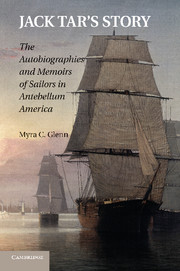Book contents
- Frontmatter
- Contents
- Acknowledgments
- List of Abbreviations
- Introduction: Why Study Antebellum Sailor Narratives
- 1 Stories of Escape, Freedom, and Captivity: Seamen Authors Recall Their Early Years
- 2 Manhood, Nationalism, and Sailor Narratives of British Captivity and the War of 1812
- 3 Exploring the Meaning of Revolution in the Americas: Sailor Narratives of the Haitian and South American Wars of Independence
- 4 Defending One's Rights as a Man and an American Citizen: Sailor Narratives as Exposés of Flogging
- 5 Straddling Conflicting Notions of Masculinity: Sailor Narratives as Stories of Roistering and Religious Conversion
- Afterword
- Appendix
- Index
Afterword
Published online by Cambridge University Press: 05 October 2010
- Frontmatter
- Contents
- Acknowledgments
- List of Abbreviations
- Introduction: Why Study Antebellum Sailor Narratives
- 1 Stories of Escape, Freedom, and Captivity: Seamen Authors Recall Their Early Years
- 2 Manhood, Nationalism, and Sailor Narratives of British Captivity and the War of 1812
- 3 Exploring the Meaning of Revolution in the Americas: Sailor Narratives of the Haitian and South American Wars of Independence
- 4 Defending One's Rights as a Man and an American Citizen: Sailor Narratives as Exposés of Flogging
- 5 Straddling Conflicting Notions of Masculinity: Sailor Narratives as Stories of Roistering and Religious Conversion
- Afterword
- Appendix
- Index
Summary
There is an Indian story – at least I heard it as an Indian story – about an Englishman who, having been told that the world rested on a platform which rested on the back of an elephant which rested in turn on the back of a turtle, asked (perhaps he was an ethnographer; it is the way they behave), what did the turtle rest on? Another turtle. And that turtle? “Ah, Sahib, after that it is turtles all the way down.”
The anthropologist Clifford Geertz tells the above anecdote to illustrate a crucial point: past events and the stories constructed about them are so complex that it is ultimately impossible to get to the bottom of their multiple meanings. There are always more turtles to uncover as one engages in the process of analysis, interpretation. Yet if definitive interpretations elude historians that does not absolve them from trying to make sense of the past as best they can by subjecting extant texts to analysis.
Jack Tar's Story has done this with the life narratives of antebellum American sailors. These memoirs and autobiographies were deceptive. On the surface, they seemed like straightforward recollections of what these men experienced during their seafaring years. But, as this book has shown, these narratives actually offered richly detailed, multilayered stories about their authors' experiences, including impressment, combat, incarceration, flogging, roistering, and religious conversion.
- Type
- Chapter
- Information
- Jack Tar's StoryThe Autobiographies and Memoirs of Sailors in Antebellum America, pp. 175 - 178Publisher: Cambridge University PressPrint publication year: 2010

